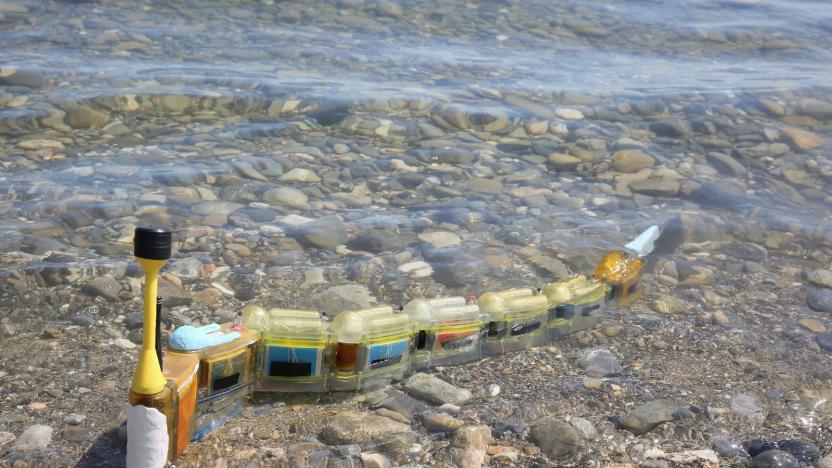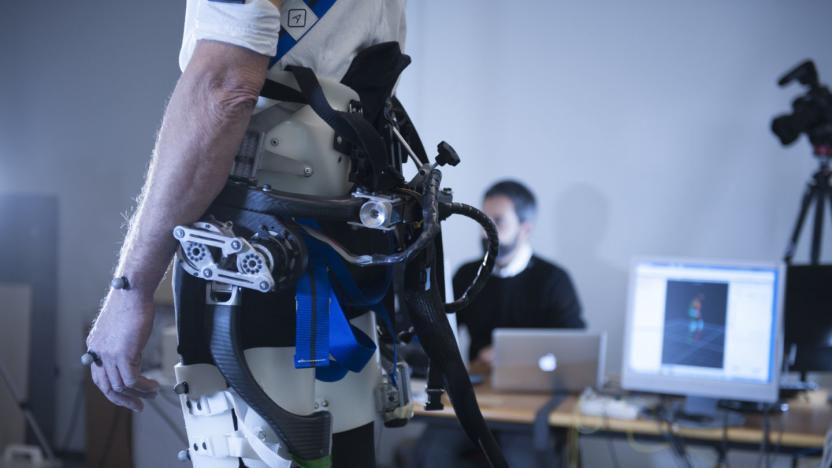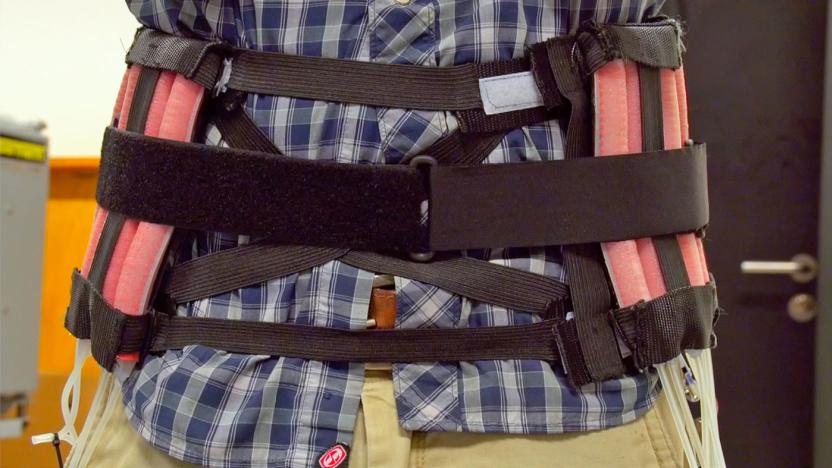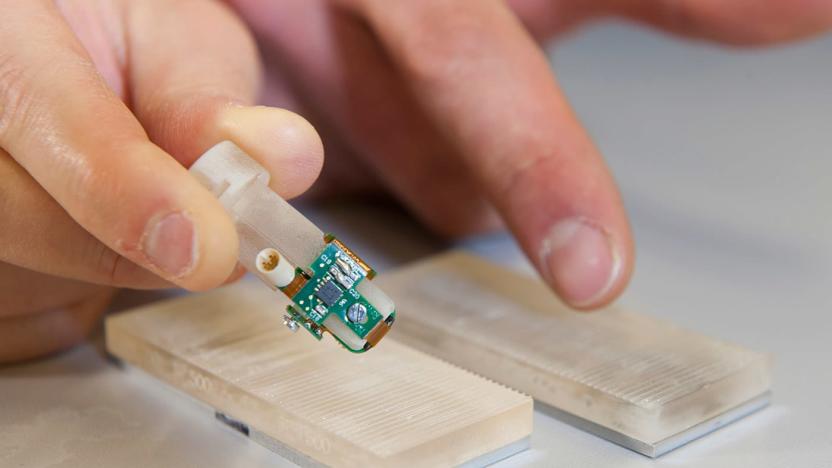EPFL
Latest

Edible robot surgeons will cure you from the inside out
Back in 1985, the best robotic surgeon we had was the Puma 560, a manipulator arm just barely more advanced than Rocky Balboa's robo-butler. Just barely. The Puma was nevertheless revolutionary. It was the very first mechanical operator, progenitor to steady-handed robo-surgeons like the DaVinci system. But in the near future, robots will no longer be cutting into us -- from the outside, at least.

Modular robotic eel hunts for sources of water pollution
We already have ways to measure the levels of pollution in bodies of water, but an eel-inspired robot can do the job faster and more effectively. The researchers from the Swiss Federal Institute of Technology and other institutions have created a modular robotic eel that can swim through contaminated water to pinpoint sources of pollution. Each module is equipped with a different type of sensor, including biological ones, like fish cells, live crustaceans and modified bacteria. Scientists can customize the eel for different locations by choosing the modules they need and leaving the others out of the configuration.

Scientists create ride-hailing tech that hides your travel data
When you use a ride-hailing app, you tell the company where you are and where you're going. That's all well and good if those firms truly will never use your data, but some of them don't exactly have a stellar reputation when it comes to privacy. That's why a team of scientists from the École Polytechnique Fédérale de Lausanne have developed a new ride-hailing technology that encrypts your travel data and hides them from the app's developers themselves. They didn't even patent their technology in case Uber or any of its rivals are interested in adopting it.

Robotic exo-shorts safely twist old folks out of falls
Robotic exosuits have already found use in a variety of medical applications from helping Parkinson's patients walk more easily to letting kids with spinal muscular atrophy play again. Now a team of researchers from the EPFL have developed a pair of wearable "exo-shorts" (given they only cover the upper thigh and hips) which monitors the steps of the user and automatically jerks them upright out of stumbles and falls.

Touchable BlindPad puts visual information at your fingertips
This touchscreen tablet operates differently than your usual iPad, with 192 magnetic buttons across its 12 x 15cm surface. They can move up and down almost instantaneously to create patterns representing the layout of a room or other visual data and hold their position thanks to two steel plates inside the tablet or vibrate. That enables visually impaired users to "read" it with their fingers. Researchers at the École polytechnique fédérale de Lausanne (EPFL) say it's intended as a complement to a Braille display, or white canes with audio GPS embedded for navigation.

The next robot crawling through your gut could be a gummi bear
The future of robotics is decidedly squishy. We've already seen gel-based 'bots that can catch fish, mimic octopi and even ones that can keep your heart pumping. And, if the researchers from Switzerland's EPFL are successful, they could soon be crawling around in our intestines as well.

Researchers give driverless cars better cooperation skills
Are you really ready to ride with just a robot at the wheel? To make self-driving cars safer, researchers from the École Polytechnique Fédérale de Lausanne (EPFL) in Switzerland want them to communicate both with each other and non-robotic vehicles to avoid any nasty surprises. As such, they rigged up three vehicles, including a robotic truck and non-autonomous vehicle, to function as one unit on a real road. By working in a team and using each others' sensors, the vehicles were able to anticipate each others' moves, making lane change maneuvers safer.

Robo-reptiles spy on their flesh-and-blood counterparts
The BBC One nature show Spy in the Wild wanted to get up close and personal with some crocodiles and monitor lizards. Instead of setting up hidden cameras, though, its producers got in touch with the École Polytechnique Fédérale de Lausanne's famous robotics division. Apparently, they saw Pleurobot, the robotic life-like salamander EPFL made, and wanted machines that can blend in with real reptiles. The team ended up building two remote-controlled robots representing the two species with cameras for eyes.

ICYMI: Basketball is about to get even more stats-heavy
try{document.getElementById("aol-cms-player-1").style.display="none";}catch(e){}Today on In Case You Missed It: The National Basketball Association signed a seven-year agreement to use a computer-vision, artificial intelligence system that analyzes on-court action in ways average viewers couldn't spot as they watch.

ICYMI: End forgetfulness with the e-version of a Post-It.
try{document.getElementById("aol-cms-player-1").style.display="none";}catch(e){}Today on In Case You Missed It: A German researcher developed a digital Post-It note that never dies as long as the small solar panel gets sunlight. They can be stuck just about anywhere. Meanwhile, EPFL scientists are creating soft robots to act as artificial muscles. So far they see the most success with a belt to help support the weight of people who've had strokes. Finally, the stop motion video of a Death Star being created is a fun watch, as is the disturbing promo video for Google's newest app, SprayScapes. As always, please share any interesting tech or science videos you find by using the #ICYMI hashtag on Twitter for @mskerryd.

Muscle-mimicking soft robots can help with physical therapy
Some soft robots can wriggle into tight spots and swim like a real octopus. These ones developed by a team from the École polytechnique fédérale de Lausanne (EPFL), however, are also capable of doing something more: they can help with the physical rehabilitation of people recovering from injuries and illnesses. The EPFL team have created a number of flexible, reconfigurable machines that can mimic human muscles' movement. They're made of silicon and rubber -- though the team also made a variant using a thick paper shell -- and they can be controlled by manipulating how much air they have inside.

ICYMI: Better walking bot and an anti-aging breakthrough
try{document.getElementById("aol-cms-player-1").style.display="none";}catch(e){}Today on In Case You Missed It: Georgia Tech overhauled its DURUS robot to walk with a human-like gait that makes it the most efficient bipedal robot. Scientists at the EPFL did some solid research into the pomegranate fruit that shows it can counteract disease and extend the life of worms by 50 percent and endurance in rodents by 40 percent. Human trials are happening now. You can see the latest 3D bone printer here and what the FBI has been doing with iris scans, here. As always, please share any interesting tech or science videos you find by using the #ICYMI hashtag on Twitter for @mskerryd.

ICYMI: Salamander bot and allergy cells: Good for something
try{document.getElementById("aol-cms-player-1").style.display="none";}catch(e){}Today on In Case You Missed It: A robotic salamander was invented by the EPFL and has a true to life spinal cord. Also researchers at the University of Virginia School of Medicine found that immune cells that normally create an over-reaction in some people, resulting in allergies or asthma, may also protect people against a certain kind of fatal infection. Finally, University of Buffalo researchers are making their own lava, you know, for science. As always, please share any interesting tech or science videos you find by using the #ICYMI hashtag on Twitter for @mskerryd.

Salamander robot can walk, crawl and swim like the real deal
One of the latest robots out of the Swiss Federal Institute of Technology in Lausanne (EPFL) can mimic the way a real salamander moves, whether on land or in the water. The EPFL scientists call it Pleurobot (after the species Pleurodeles waltl) and designed it after studying x-ray videos showing the amphibian walking and swimming. According to the institute, other scientists from EPFL had built salamander robots in the past, but this has the most realistic movements thus far. It's also the first one that's "accurately based on the 3D motion of the animal's skeleton."

ICYMI: The dogbot and a heart strap that beats surgery
try{document.getElementById("aol-cms-player-1").style.display="none";}catch(e){}Today on In Case You Missed It: Boston Dynamics introduced a new robot to the lineup and this one is both the smallest yet, and most adorable. The SpotMini is just two feet tall but in the video Boston Dynamics released, shows it can do dishes, throw cans away and creep around for a good 90 minutes on an electric charge. Meanwhile the EPFL designed a new medical device that looks not-entirely unlike an old school slap bracelet, except it's made of silicon and is designed to grip and squeeze the aorta, keeping the heart beating while a patient might be waiting for a heart transplant. Theater fans will want to know about New York's decision to ban robot buyers; while politically-minded folks (not already talking about Great Britain's vote to leave the EU) will want to hear about C-SPAN's decision to broadcast Periscope videos of the Democrat's sit-in. As always, please share any interesting tech or science videos you find by using the #ICYMI hashtag on Twitter for @mskerryd.

ICYMI: A space-based full service stop, bat drone and more
#fivemin-widget-blogsmith-image-426380{display:none;} .cke_show_borders #fivemin-widget-blogsmith-image-426380, #postcontentcontainer #fivemin-widget-blogsmith-image-426380{width:570px;display:block;} try{document.getElementById("fivemin-widget-blogsmith-image-426380").style.display="none";}catch(e){} Today on In Case You Missed It: DARPA's own AAA satellite service to service satellites orbiting Earth could launch in about five years, if all the testing goes as planned. A new drone is based on the form of a bat and the resemblance is uncanny. And Google is helping robotic graspers learn hand-eye coordination by giving them new objects to pick up. If you've followed along with some of the 3D-printed prosthetics we've done stories on, you'll want to see this glitter shooting, darling girl. And as always, please share any great tech or science videos you find by using the #ICYMI hashtag on Twitter for @mskerryd.

Bionic finger makes amputee feel texture on his phantom hand
Someday, amputees might be able to get prosthetics that can discern shapes and feel texture, thanks to the Swiss Federal Institute of Technology in Lausanne (EPFL). Its scientists have succeeded in designing a bionic fingertip (PDF) that can make amputees feel textures and even differentiate between rough and smooth surfaces. The team asked Dennis Aabo Sørensen, who lost his left hand in an accident, to test it out. He said the sensations it gave him were almost like what you'd feel with your own hand.

ICYMI: Moon waystation, human skin like bananas and more
#fivemin-widget-blogsmith-image-92297{display:none;} .cke_show_borders #fivemin-widget-blogsmith-image-92297, #postcontentcontainer #fivemin-widget-blogsmith-image-92297{width:570px;display:block;} try{document.getElementById("fivemin-widget-blogsmith-image-92297").style.display="none";}catch(e){} Today on In Case You Missed It: The European Space Agency wants to put a permanent base on the moon, for all agencies to share. A new solar plant in Nevada is the first to store 10 hours of energy in salt, continuing to produce electricity overnight. And researchers are studying bananas because an enzyme in their skin is just like one produced by human skin. Maybe that's why they taste so good? JK, that was just for Hannibal Lecter. We also wanted to bring you this latest Guinness World Record, of an electrified skateboard traveling at 59.5 miles per hour. As always, please share any interesting science or tech videos, anytime! Just tweet us with the #ICYMI hashtag to @mskerryd.

Software maps the 'Star Wars' universe
You may have a good feel for the scope of the Star Wars universe, but Swiss researchers just took things to another level. They've created maps of the space fantasy series' expanded universe that visualize the connections between 20,000 characters, spanning a period of 36,000 years. The results are surprisingly pretty (you're only seeing a fraction of it above) and help fill in gaps for characters that aren't fully fleshed out, such as where they sit in the timeline. They also turn up facts that might not be readily apparent, even if you're well-versed on the likes of the Old Republic or Grand Admiral Thrawn. For example, just shy of 80 percent of characters are human -- clearly, writers aren't going out of their way to include more Sullustans and Wookiees in their stories.

Soft robotic fingers can pick up even fragile objects
École polytechnique fédérale de Lausanne's (EPFL's) new robotic grippers don't look anything like fingers, but they can pick up even delicate objects like eggs. Their secret? Electroadhesion. That's the same phenomenon that makes a balloon's surface sticky enough to adhere to a wall when you rub it against your hair. The EPFL's grippers are flexible and stretchable electrode flaps that act like a thumb-index finger combo.





